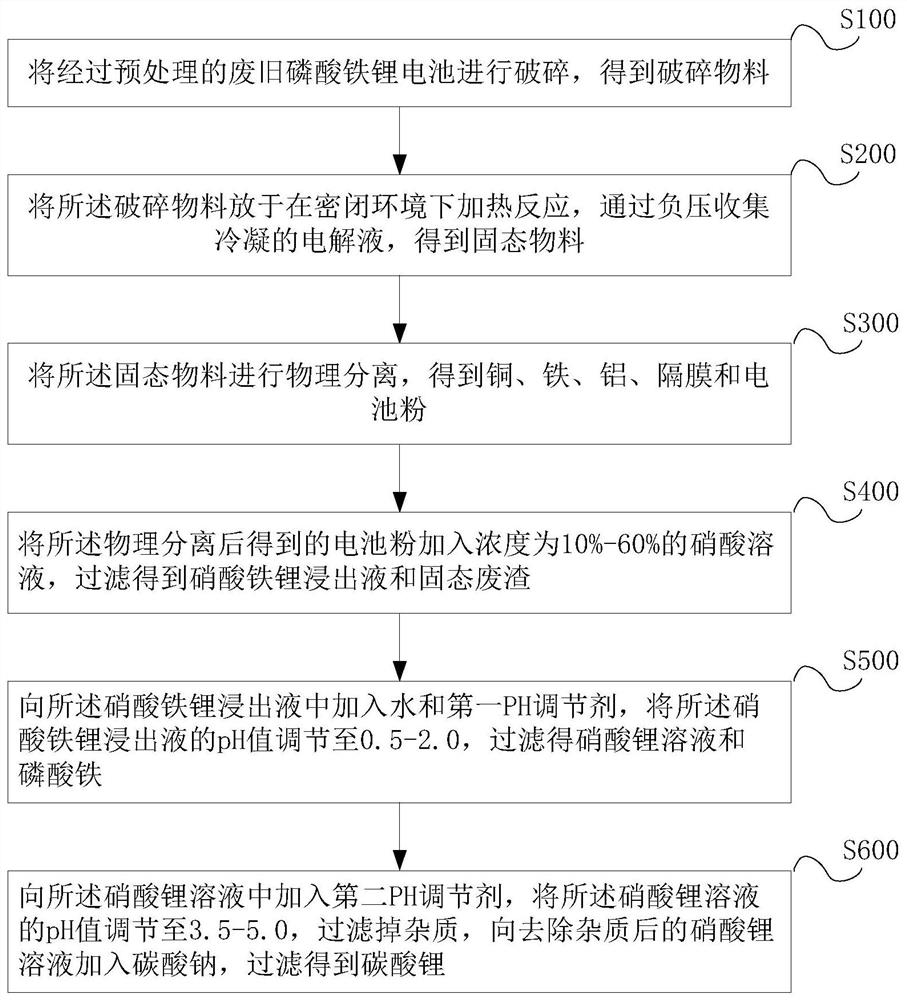Recovery method of waste lithium iron phosphate battery
A lithium iron phosphate battery, recycling method technology, applied in battery recycling, waste collector recycling, secondary batteries and other directions, can solve the problems of secondary environmental pollution, long process flow, large amount of waste residue, etc., and achieve low energy consumption of auxiliary materials, The effect of short process flow and efficient recovery
- Summary
- Abstract
- Description
- Claims
- Application Information
AI Technical Summary
Problems solved by technology
Method used
Image
Examples
Embodiment 1
[0035] Step 1: crush the pretreated waste lithium iron phosphate battery to obtain crushed materials;
[0036] Step 2: Put the crushed material in a closed environment for heating reaction, collect the condensed electrolyte by negative pressure to obtain solid material, the reaction temperature is 150°C, and the collected electrolyte can be purified and reused as battery electrolyte;
[0037] Step 3: Physically separate the solid materials to obtain copper, iron, aluminum, diaphragm and battery powder, wherein the content of copper in the battery powder is 0.2%-6.0%, the content of aluminum is 0.2%-6.0%, and the content of iron is 0.2% %-6.0%;
[0038] Step 4: adding the battery powder obtained after the physical separation into a nitric acid solution with a concentration of 30%, reacting for 6 hours at a reaction temperature of 40°C, and filtering to obtain lithium iron nitrate leaching solution and solid waste residue;
[0039] Step 5: Add water, lithium hydroxide, and lit...
Embodiment 2
[0042] Step 1: Discharge the waste lithium iron phosphate battery first, then crush it to obtain crushed materials;
[0043] Step 2: put the crushed material in a closed environment for heating reaction, collect the condensed electrolyte through negative pressure to obtain solid material, and the reaction temperature is 200°C;
[0044] Step 3: The solid material is subjected to secondary crushing, and the diameter of the material after secondary crushing is less than 1.5cm; the secondary crushing material is screened, and then magnetic separation and gravity separation are used to obtain copper, iron, and aluminum , diaphragm and battery powder, wherein the content of copper in battery powder is 0.2%-6.0%, the content of aluminum is 0.2%-6.0%, and the content of iron is 0.2%-6.0%;
[0045] Step 4: add the battery powder obtained after the sorting to a nitric acid solution with a concentration of 50%, react for 10 hours, and the reaction temperature is 60°C, filter to obtain li...
Embodiment 3
[0049] Step 1: crush the pretreated waste lithium iron phosphate battery to obtain crushed materials;
[0050] Step 2: put the crushed material in a closed environment for heating reaction, collect the condensed electrolyte through negative pressure to obtain solid material, and the reaction temperature is 250°C;
[0051] Step 3: Physically separate the solid materials to obtain copper, iron, aluminum, diaphragm and battery powder, wherein the content of copper in the battery powder is 0.2%-6.0%, the content of aluminum is 0.2%-6.0%, and the content of iron is 0.2% %-6.0%;
[0052] Step 4: add the battery powder obtained after the physical separation into a nitric acid solution with a concentration of 10%, react for 15 hours at a reaction temperature of 80°C, and filter to obtain lithium iron nitrate leaching solution and solid waste residue;
[0053] Step 5: adding water and sodium carbonate to the lithium iron nitrate leaching solution, adjusting the pH value of the lithium...
PUM
| Property | Measurement | Unit |
|---|---|---|
| diameter | aaaaa | aaaaa |
Abstract
Description
Claims
Application Information
 Login to View More
Login to View More - R&D Engineer
- R&D Manager
- IP Professional
- Industry Leading Data Capabilities
- Powerful AI technology
- Patent DNA Extraction
Browse by: Latest US Patents, China's latest patents, Technical Efficacy Thesaurus, Application Domain, Technology Topic, Popular Technical Reports.
© 2024 PatSnap. All rights reserved.Legal|Privacy policy|Modern Slavery Act Transparency Statement|Sitemap|About US| Contact US: help@patsnap.com








